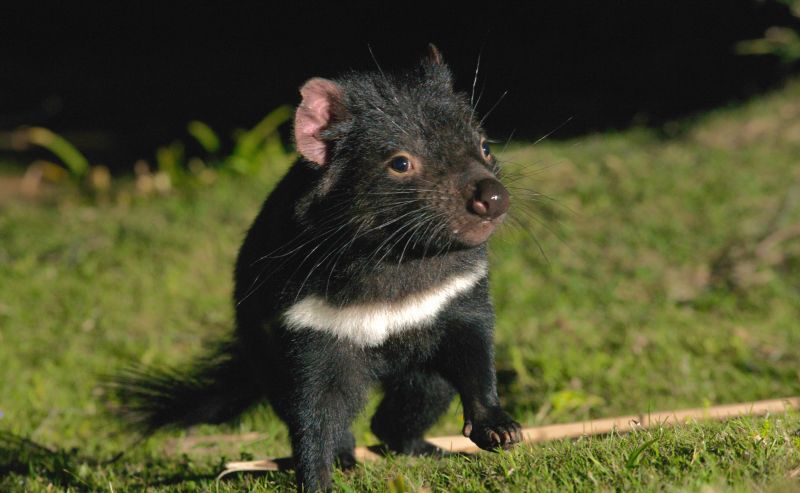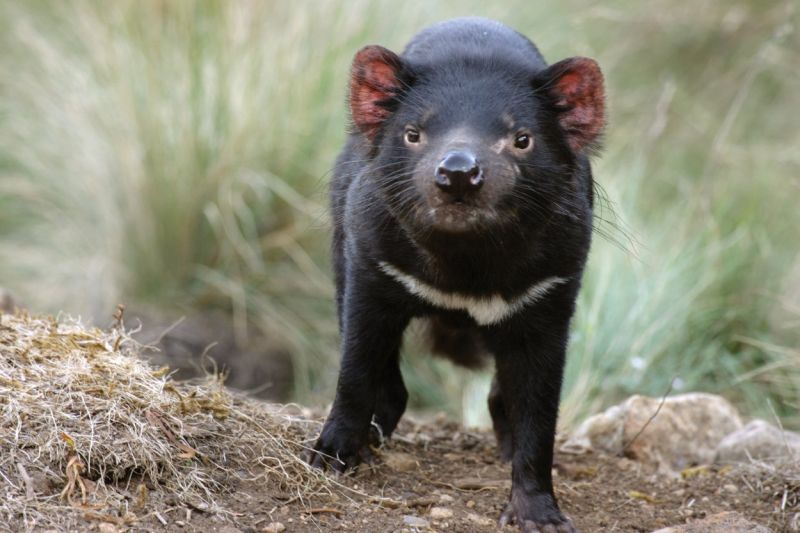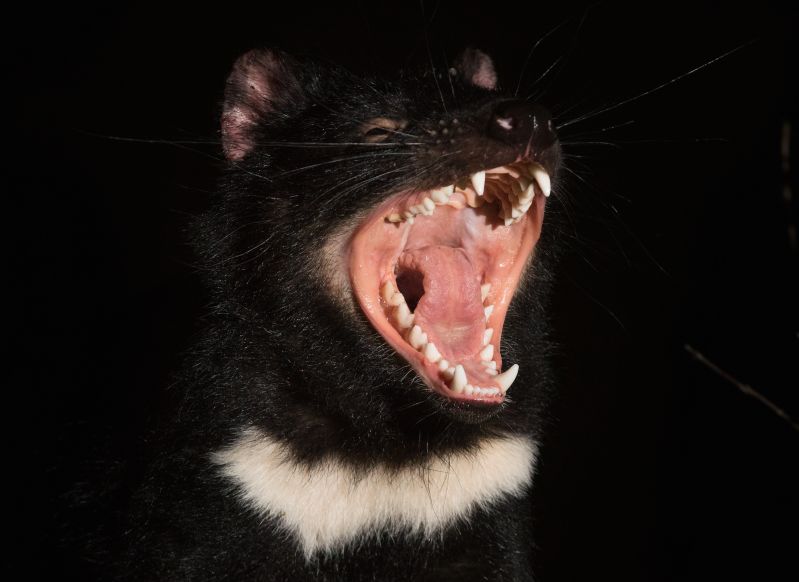Once widespread across the country, the Tasmanian Devil (Sarcophilus harrisii) is now restricted to the island state of Tasmania, due to the arrival of Dingos to Australia some 3500-4000 years ago. Known locally as 'Tassie Devils', these nocturnal carnivorous marsupials typically inhabit dry eucalypt forests and woodlands and are found across the whole island, with a population introduced to Maria Island off the east coast.
What is a marsupial?
A marsupial is a subclass of mammals born after a short pregnancy. With strong front limbs, the partially-developed young climbs into the mother's pouch (via the cloaca, or pelvic opening), where it attaches itself to a teat and continues to develop. While pouches are a common marsupial characteristic, not all have them. Numbats, for instance, do not. Instead, the young hang from the mother's teat.
Size and appearance
Male Tasmanian Devils weigh around 9 kg (18 lb), with a body length of 65 cm (26 in). Although similar in appearance, females are slightly smaller.
Their fur is black, with white markings, and fat, coarse-haired tails. Their head is proportionately large, housing powerful jaws and strong teeth designed for crunching the bones of their prey.
Behaviour
Tasmanian Devils are typically solitary, emerging from their dens at night to hunt alone. It is their preference to consume carcasses alone, however often other individuals will discover the feeding frenzy and join in. Groups of up to six can come together to feed, which can become loud and aggressive. Screeching, biting, and scratching are often observed, with scarring common, especially in older individuals.
Mating occurs in March, with females giving birth to up to four young three weeks later. She will carry these in her pouch (which, like wombats, is backward-facing) until August, at which point she will drop them in her grass-lined den. By the following February, they are weaned and independent.
Life expectancy is relatively short, at just six years. Females become sexually active at two years, meaning there are finite opportunities for reproduction.

Diet
Being carnivorous, Tasmanian Devils feed on meat. Their generic name, Sarcophilus, literally means 'flesh-lover'.
Possums, wallabies and wombats are their key food sources, however, they are also scavengers. Their strong sense of smell allows them to easily locate animal carcasses at long range, from fish washed up on the beach, to deceased domestic sheep and cows.

Conservation status
Quick fact
With powerful jaws and strong teeth, Tasmanian Devils can eat every part of its prey. Upon inspection of their droppings, you will likely observe splinters of bone.
Although still considered common in Tasmania, Tassie Devils are classified as 'endangered', having been upgraded from vulnerable in 2009. There are two key reasons for the declining population:
- An outbreak of Devil Facial Tumour Disease (DFTD) causes severe, cancerous facial tumours which, once infected, kill individuals within a few months of the cancer becoming visible. Fighting among affected individuals allows the transfer of cancerous cells to a new, uninfected animal. While vaccines are under development, and making good progress, there is no true cure yet.
- The introduction of the European fox to Tasmania in 2000 has increased competition for food, putting further pressure on devil populations.

Where to see Tasmanian Devils in the wild
Inhabitating eucalyptus woodlands and forests across Tasmania, Tasmanian Devil encounters are generally opportunistic. This, along with the fact that they are nocturnal, makes it even more important to travel with a local wildlife guide from Premier Travel Tasmania.
On Maria Island, located off the east coast of Tasmania, a population of healthy, disease-free Tasmanian Devils was reintroduced in 2012. So far, this program has been successful and provides hope for the long-term survival of the species. As part of The Maria Island Walk, guests have the opportunity to search for devils in the evenings accompanied by their guide.
Featured Tour: 6 Day Tasmanian Devil Encounter Private
Operator: Premier Travel Tasmania
Duration: 6 days
This immersive wildlife adventure takes you across an extraordinarily diverse range of habitats including lush valleys, glacial lakes, spectacular rivers and ancient rainforests. Kangaroos, wombats, quolls, Platypus, wombats and bird flourish here, but it is the island's most famous resident, the Tasmanian Devil, that is a highlight for many.
Included in your 6 day package, you will find your own personalised Tassie Devil Adoption Package. Visit your adopted Tassie devil and see how this program assists with the breeding, rehabilitation, and reintroduction of this endangered species.
Featured Tour: The Maria Island Walk
Operator: The Maria Island Walk
Duration: 4 days
This four-day guided walk across magnificent Maria Island, combines intimate wildlife encounters, fascinating history, pristine white sand beaches, and locally sourced gourmet food. As a vital location for numerous threatened and endangered species, Maria is now an island sanctuary and one of the best places in Australia to observe Common Wombats, Tasmanian Devils, Cape Barren Geese, Forester Kangaroos, Bennett's Wallabies and 125 species of birds.
FAQs
Are they dangerous to humans?
No. Despite their name and appearance, they are quite timid. They do not attack people, although they will defend themselves if attacked, cornered or trapped.
Can humans become infected by the Devil Facial Tumour Disease (DFTD)?
No, this disease spreads directly between devils and poses no risk to humans.
How did they get their name?
Early European settlers heard the terrifying nocturnal screams, coughs and growls from the forest. Further investigation led them to this animal with wide jaws and large, sharp teeth, which they called "The Devil".

